
No matter how closely we follow best practices for safe driving, eventually, we or someone we know might be involved in a car crash. With luck, it won’t be anything more than a fender bender, but it could also be something severe. No matter the situation, you might need to replace your child’s car safety restraints (i.e., your car seats). There are a number of seats that follow the criteria set by the NHTSA for reusing car seats after minor crashes (I’ll review those in a moment), but most car seat manufacturers will ask you to replace your car seats after any crash, no matter how minor, even if no children were using the seats.
The number one rule to keep in mind is that the manual (or car seat manufacturer) is the absolute authority in determining whether or not to replace a car seat after a crash. If you can’t find the manual, send an email or make a phone call to the manufacturer. The number will almost always be on the seat itself, and if it’s not, you can find it online (as well as email information). Let’s take a look at what to do immediately after a crash, whether you’ll need to replace your car seat, whether your insurance company will cover your seats, and the policies and contact information for a variety of car seat manufacturers with a US and Canadian presence.
What to do right after a crash when you have children in car seats

Immediately after a crash, the first thing to do is to call for help (911 in the United States and Canada). Barring an absolute emergency (e.g., a risk of fire, water immersion, falling over a cliff, etc), you’ll want to remain in your vehicle and keep all children in their car seats. Child restraints are designed to stabilize injured children, and paramedics will almost always use them to transport children to hospitals after serious crashes.
Many parents and caregivers often ask themselves if they can use potentially damaged seats to drive away from crashes (e.g., home) in crashes that don’t require that children be transported to a hospital. The best answer here is to do what seems best at the time. If you can immediately buy replacement car seats or have someone bring replacement seats to you, this is best. However, we rarely crash in the parking lots of stores that sell car seats, and we rarely have trusted friends or family available to bring us car seats within minutes of a crash. As a result, you’ll want to use your best judgment.
If your car restraint needs to be replaced after a crash, per the manufacturer, no matter how minor the crash, this suggests you shouldn’t use it. However, between using a seat that a manufacturer tells me not to reuse after a minor crash and driving my pre-adolescent child home in a seat belt, I’ll use the car seat every single time. Children younger than 10-12 won’t pass the 5-step test for seat belt safety, and that’s not a risk I’d recommend parents take unless absolutely necessary (e.g., no car seats whatsoever or severely damaged car seats).
How to tell if you need to replace your kids’ car seats after a crash – minor, moderate, or severe
For a moderate or major crash, you’re going to need to replace your seats, even if you didn’t have children inside them at the time. Car seats, like bicycle helmets, aren’t made to handle more than one significant impact; they won’t necessarily perform the same way twice.
For a minor crash, most manufacturers will still want you to replace the seat. However, there are a few manufacturers that allow you to follow the NHTSA’s guidelines for reuse following mild crashes. These are the criteria:
- You were able to drive your vehicle away from the crash site.
- The vehicle door closest to the car seat had no damage.
- None of the vehicle’s occupants were injured.
- If you had airbags (and hopefully you did), they did not deploy, AND…
- The car seat itself was not visibly damaged.
All of these criteria need to be fulfilled for the crash to count as minor. If you’re not sure if what occurred was even serious enough to count as a crash (e.g., if you backed into a car while parallel parking or if you nosed into your garage), the best thing to do is to get in touch with your car seat’s manufacturer; they have experience with such calls and emails and will be happy to help you figure out whether what you experienced even counted as a crash or whether it was so minor it was irrelevant to your car seat’s safety.
When will my car insurance provider replace car seats that have been involved in a crash?
The only sure answer here is “it depends.” To fully know, you’ll need to contact your insurance company. Your odds of replacement will be significantly greater if the other party is judged to be at fault or if you have complete coverage. However, there are plenty of no-fault states and each company is different. In California, the insurance code requires insurance companies to replace car seats if they were occupied or damaged in a collision, but this provision doesn’t exist in other states.
Insurance companies will frequently try to avoid replacing seats based on their interpretations of crash severity, but the car seat manufacturer’s regulations override those of any insurance company, and if the company states it will replace a seat if they judge it to be necessary for safety, a referral to the manual or a statement from the manufacturer will frequently be enough to convince them of its necessity. Similarly, you’ll want to make sure any reimbursement offers are at least equal to the value of the seats; if you spend money on a Clek Fllo or Peg Perego Flex 120, you don’t want to receive a $50 all-in-one seat from WalMart as its replacement. While both may pass the same crash tests, there’s presumably a reason you picked the seats you did to begin with (e.g., to allow for extended rear-facing or boosters that would allow your kids to pass the 5-step test).
Keep in mind that if your insurance company chooses not to replace your seats, that doesn’t mean that they don’t need replacing; if your car seat manual or manufacturer indicates the seat needs to be replaced, it needs to be replaced. Your kids are worth it.
What are the car seat replacement policies for each car seat manufacturer in the US / Canada?
As noted above, the absolute best way to find out your car seat’s replacement policy is to read the manual or contact the car seat manufacturer. The list below is a general one, and as everything else on this site, is not intended as legal counsel. If you have any questions whatsoever on what to do with a car seat after a crash, it’s time to reach for the manual or for the manufacturer; they made the seat and they know their policies on replacement better than anyone else.
Generally speaking, Britax and UPPAbaby are the only major car seat manufacturers that follow the minor crash criteria of the NHTSA while urging replacement after moderate to severe crashes. Every other manufacturer either recommends replacement after any crash, no matter how minor, or requires manual review and manufacturer contact. In other words, for BabyTrend, BubbleBum, Chicco, Clek, Combi, Cosco, Dorel, Maxi-Cosi, Safety 1st (both Maxi-Cosi and Safety 1st are divisions of Dorel), Cybex, Diono, EvenFlo, Graco, Harmony, KidsEmbrace, Orbit Baby, Peg Perego, Recaro, RideSafer, and The First Years all require you to either replace the seats, read the manuals, or contact the manufacturers.
To sum things up, in the vast majority of cases, you’re going to need to check with the manufacturers or replace seats anyway. While this may seem onerous and expensive, the goals here are to keep your children safe, and a few hundred dollars in car seats are much cheaper than any hospital stay, or worse. Remember that your insurance company might be able to help you replace your car seats, depending on your policy and the circumstances of the crash. And above all, if you’re in the market for a new car seat, please see my reviews on recommended car seats (or Canadian recommended car seats if in Canada) for suggestions on the best new and old car seats for children between birth and 12. See here for best practices in child car seat use and here for best practices in overall auto safety, whether in driving technique, vehicle selection, or road design.
 If you find my information on best practices in car and car seat safety helpful, you can buy my books here or do your shopping through this Amazon link. Canadians can shop here for Canadian purchases. Have a question or want to discuss best practices? Send me an email at carcrashdetective [at] gmail [dot] com.
If you find my information on best practices in car and car seat safety helpful, you can buy my books here or do your shopping through this Amazon link. Canadians can shop here for Canadian purchases. Have a question or want to discuss best practices? Send me an email at carcrashdetective [at] gmail [dot] com.

